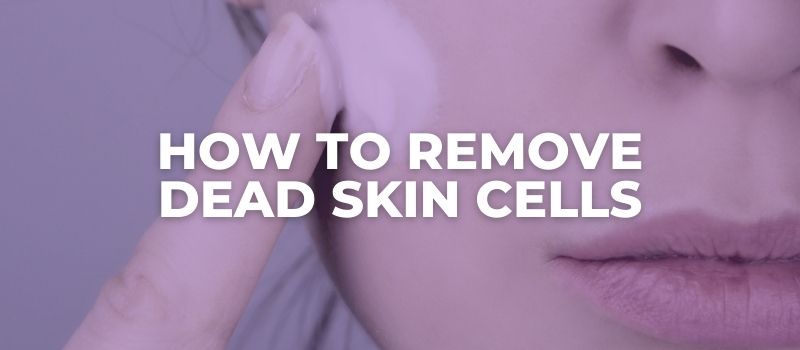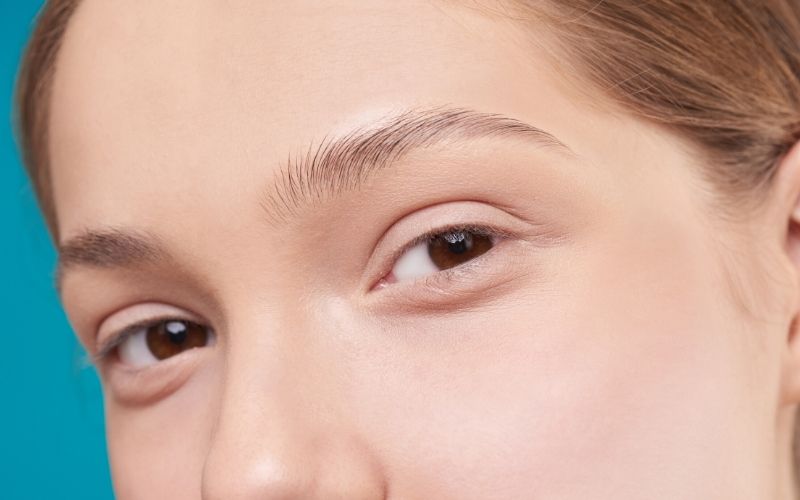To remove dead skin cells from your face, you need to exfoliate your face.
Skincare enthusiasts might say “Wow, what a revelation, we all knew that!”
However, you would be surprised at how many people still resort to using harsh methods of exfoliation that may be a potential culprit for all sorts of skin problems down the line.
If you want to learn how to exfoliate your skin the right way and never worry about what might happen to your skin down the line, be sure to read this article.

How To Safely Remove Dead Skin Cells (From Your Face)?
The most efficient way to remove dead skin cells from your face is through gentle exfoliation and this means incorporating fruit acids or enzymes that mimick the natural shedding process of the skin cells.
Acids such as alpha-hydroxy acids, beta hydroxy acids, and polyhydroxy acids work to gently dissolve the bonds (proteins) that hold dead skin cells together and allow the skin cells to shed naturally and much quicker than they usually would.
Basically, exfoliating acids encourage something that already happens naturally and makes the entire process a little quicker.
On the other hand, Enzymes do the same thing but in an even gentler way than exfoliating acids. Enzymes work by breaking down the protein keratin that holds the dead skin cells together, allowing them to slough off naturally.
So, using exfoliating acids such as alpha-hydroxy acids, beta hydroxy acids, polyhydroxy acids, and fruit enzymes are the best and most gentle ways to remove dead skin cells from your face.
How NOT To Remove Dead Skin Cells From Your Face?
This one is very important because many people are exfoliating their faces the wrong way and this is something that may turn out to be the culprit of many skin concerns down the line.
Washcloths, scrubs, sponges, and other manual methods of exfoliation are a few ways how not to remove dead skin cells from your face, simply because these methods can have quite a harsh effect on the skin and create what is known as micro-tearings in the skin.
By using manual methods of exfoliation, you are not gently breaking down the proteins that hold dead skin cells together, therefore, you aren’t allowing them to shed naturally, but you are completely removing them from your skin.
Scrubs, for example, often contain large and irregularly-shaped particles such as ground-up shells, fruit pits, or volcanic rock that can contribute to these micro-tears.
Micro-tears then gradually weaken the skin’s barrier and once the skin’s barrier is weakened, you are allowing your skin to become more prone to getting damaged by external factors.
A weakened skin barrier may result in dryness, flaky patches, redness, sensitivity, inflammation, as well as a ton of bacteria entering your skin and causing all sorts of fuck-ups that will surely show sooner or later.
The 5 Best Exfoliating Products You Can Use
Here are my top 5 recommended exfoliating products for your face:
Paula’s Choice – 2% Liquid BHA Exfoliant

This is the best exfoliating solution if you have oily/combo or even dry skin but you can still see those pesky little blackheads or occasional pimples every now and again.
It has a slightly thick and oily texture that will not dry out your skin, but since it’s also an exfoliator, it also won’t contribute to excess oil production that can potentially clog your pores and create more acne breakouts.
NB: You can read my full review of the Paula’s Choice BHA liquid exfoliant.
Paula’s Choice – Regular Strength 2% Salicylic Acid Exfoliator

This one is perfect for oily skin types that deal with moderate acne breakouts. It has a nice and light texture, isn’t heavy on the skin, and many people tolerate it pretty well.
One thing I have to say about it is that it can sting a little for the first several uses, especially if your skin is also a little dehydrated, however, once your skin gets used to it, you will be good to go.
The Ordinary – Glycolic Acid 7% Toning Solution

This one is an amazing product for anyone that deals with dryness, dehydration, dull complexion, etc.
It’s not the ideal product for acne, but it is super excellent for removing those pesky pigmented spots that often stay behind after acne is gone as well as giving you that nice, hydrated glow.
My lovely friend Sarah from A Woman’s Confidence wrote an incredible review on this product, so you can check it out by clicking here.
The Ordinary – Lactic Acid 5% + HA 2%

This product is the most suitable for super sensitive skin types that are looking for a good exfoliation.
It didn’t do much for me, simply because my skin is quite used to stronger exfoliating acids, however, if you want to introduce your skin to gentle and decent exfoliation as a beginner, this one is the product to go for.
The Ordinary – Peeling Solution AHA 30% + BHA 2%

This one is an advanced exfoliating solution by The Ordinary and it is one product I don’t recommend beginners in chemical exfoliants to go for.
Don’t mess around with it if you don’t know what you’re doing. It is an excellent and strong peeling solution that I tend to do once every two weeks, however, I make sure not to use any exfoliators 4-5 days prior to that.
It’s a mask that you leave on your skin for as long as you can tolerate it but no longer than 10 minutes! You should then wash it off with cold water and immediately apply a nourishing moisturizer to soothe the skin.
If, on the other hand, you are already using exfoliators and can tolerate them pretty well, then it is an excellent product to try.
Frequently Asked Questions

Why Is It Important To Remove Dead Skin Cells?
Exfoliation is something that happens regularly in a good skincare routine and it is important to remove dead skin cells from the surface of the skin.
This is because these cells can be the root of many skin concerns such as dull complexion, dryness, flakiness, clogged pores that will eventually lead to acne breakouts, etc.
By removing the dead (keratinized) skin cells from the surface of your skin, you are allowing the new skin cells from underneath to make their way to the surface.
This will give your complexion a healthier, more radiant, and brighter appearance.
Are Dead Skin Cells Good?
Yes! Dead skin cells or “corneocytes” are good and they are also essential in the healthy ecosystem of the skin even though they are technically considered “dead”.
To understand what makes corneocytes so essential, let’s first explain the natural cycle of a skin cell.
First of all, cells reproduce at a rate of about 40,000 per day and new skin cells originate in the basal layer of the epidermis (which is the outermost layer of the skin).
As new skin cells are constantly created, they push older cells closer to the top layer of the epidermis and it takes anywhere between 28 – 40 days for a single skin cell to go through from creation at the basal layer to the top layer of the skin.
This purely depends on age and while your skin cells are basically being replaced every 28 days when you’re in your teens and twenties, this process starts to slow down as you age.
The role of mature skin cells is to protect the skin.
Yes. The role of mature or dead skin cells is to protect the skin and keep it from drying out as the most optimal corneocytes are the ones that have fully matured and are flattened and larger in shape and size.
These don’t look plump, bright, or radiant, but their maturity, structure, fortified cell walls, and higher surface area allows them to hold the most amounts of what is called the Natural Moisturizing Factors or NMFs.
NMFs allow the skin cells to hold on to water and maintain optimal hydration levels within the outermost layer of the epidermis, the stratum corneum.
Young and fresh cells cannot hold on to much water because they are simply not strong enough to withstand the osmotic pressure of water building up within the cells.
Over-exfoliation removes the matured corneocytes, leaving behind immature cells that may look bright, plump, and radiant, but this also leaves your skin unable to keep itself hydrated.
Therefore, while regular exfoliation should still take place in a good skincare regimen, this is definitely a process that needs to be reserved for no more than 2-3 times a week.

My name is Simone and I am a certified skin specialist. I created this website to teach my readers how to take great care of their skin and I also like to occasionally share my honest opinions on skincare products I’ve tried. You can learn more about me here.

Thanks for this 🙂 Some interesting stuff – 40,000 new skin cells a day?!?!? Great to have a sensible voice promoting the benefits of dead skin cells and not just advising people to scrub them all away. Finding the right balance is key 🙂
Definitely!
I also used to think that dead skin cells are evil because of all the misinformation I was coming across online, but all I ever got from scrubbing my dead skin cells away daily was irritation and even more acne.
Dead skin cells aren’t evil and are there to protect our skin barrier, therefore, all we need to go is help them shed naturally through gentle exfoliation instead of desperately trying to get rid of them by all costs.
Thank you for your comment!